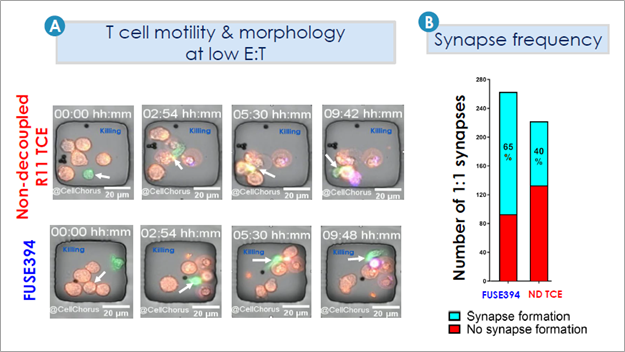TIMING data prioritizing novel T cell engager platform presented at SITC 2022
Fuse Biotherapeutics presented TIMING data at the 2022 Society for Immunotherapy of Cancer annual meeting featuring the company’s novel T cell engager that decouples efficacy from toxicity and exhaustion
PUBLICATION ALERT
The Journal for ImmunoTherapy of Cancer (JITC) has published an abstract from the 2022 Society for Immunotherapy of Cancer annual meeting (SITC 2022) featuring a novel T cell engager (TCE) platform developed by Fuse Biotherapeutics (FuseBio). Data presented by the FuseBio team included cell motility, cell morphology, and synapse formation data from CellChorus® TIMING™ assays.
FuseBio is advancing its pipeline of immune-modulating therapeutics that integrate innate and adaptive immune responses to target the destruction of tumor cells while harnessing natural immune-modulatory and immune cell educational pathways for effective and well-tolerated therapeutics.
In immuno-oncology, TCEs are antibody-based molecules that retarget and link immune cells to tumor cells. In so doing, eradication of tumors is promoted. One of the primary challenges with TCEs is balancing anti-tumor efficacy and adverse events including the induction of Cytokine Release Syndrome, neurotoxicity, immune cell exhaustion, and activation-induced cell death of immune cells.
In less than 18 months, the FuseBio team developed a TCE lead candidate that targets ROR1 (FUSE394). The data presented at SITC 2022 demonstrated that FUSE394 is potent and successfully decouples anti-tumor activity from cytokine release and T cell exhaustion. TIMING data from the CellChorus early access program also demonstrated that FUSE394 preserves T cell motility and healthy morphology and promotes 50% more synapse formation than a non-decoupled control.
T cell motility, morphology, and synapse formation in a novel TCE platform. FUSE394 maintained T cell motility, healthy T cell morphology (A, arrows follow migration of T cells stained green chasing and killing tumor cells stained red; purple indicates dead cells) and 50% more synapses (stable contacts between T cell and target cell, B) than the non-decoupled TCE. Citation: Rabinovich, B et al. JITC 2022 (preprint).
About CellChorus
CellChorus is the leader in applying artificial intelligence to visually evaluate how thousands of individual immune cells, such as T cells and NK cells, perform over time. The company applies Time-lapse Imaging Microscopy in Nanowell Grids (TIMING™) with neural network-based artificial intelligence (AI) to identify cells and evaluate their activity, including how they move, activate, kill and survive. The patent-protected CellChorus platform can link TIMING data and insights with information from other analysis modalities such as single-cell RNA sequencing and flow cytometry to provide a comprehensive understanding of cellular function, state and phenotype for the life sciences industry. Please visit cellchorus.com for more information.
Company Contact:
Daniel Meyer
Chief Executive Officer
CellChorus Inc.
TIMING@cellchorus.com
SOURCE CellChorus Inc.

